Human Learning:
What Machines Teach Us
We have taught everything to machines and continue to supply them so that they pursue the 'desire' for autonomy we would like to grant them. Isn’t it time that we started thinking that we, too, learn from them by observing their specificities or qualities? Answer at the Canadian Cultural Centre in Paris.
Premises
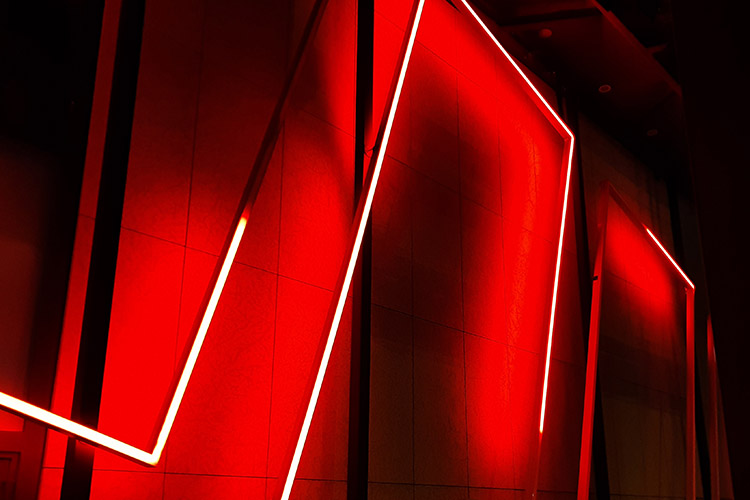
Olivier Ratsi, IIII, 2020 (production Julien Taïb).
Olivier Ratsi’s light installation IIII is made of four rectangles which are reminiscent of four zeros. Its color, red, contributes to point towards the aesthetics of digital clock displays. Let us note that the word digital comes from the Latin digitus meaning finger. Because for a very long time, we have counted on our fingers before delegating that task to machines. However, the installation counts nothing, not even the passing of time – although, as its title suggests, the artist does refer to the 'Watchmaker’s Four'. Watchmakers have an acute sense of balance down to design details, and they prefer the writing 'IIII' to the Roman figure 'IV'. Clockmaking in the 18th century being indispensable know-how for automaton makers, the real ancestors of our contemporary roboticists. The programming of clockwork thus preceded that of algorithms, which few of us can decipher. The great variability in duration of the IIII installation may very well be a language only speaking to the eye.
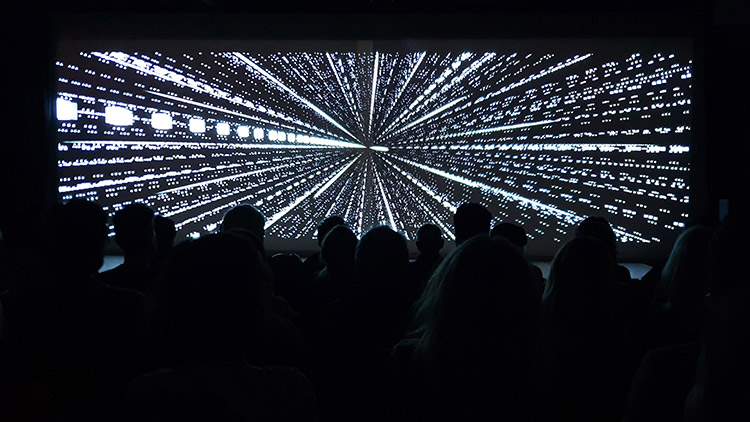
Purform, Enigma, 2019 (Elektra & UQAM).
During World War II, the fate of the world was first in the hands of those who encrypted messages, in particular through machines of the Enigma family. Until it finally recaptured by the experts who managed to decipher them, among whom was Alan Turing. As a reminder, cryptology was an art in Ancient Greece before becoming today a science associated to data. Enigma is also an artistic project of the Purform duo formed by Yan Breuleux and Alain Thibault. This performance propels its audience towards a world where data science services artificial intelligence, which is itself at the center of the main societal stakes of our era. During the performance, the machine seems to have an answer to every question, although it persists in ignoring the meaning of the word 'emotion'. It seems incapable of even contemplating to decipher it. According to experts, we are just incapable of encoding conscience. But although we cannot learn everything from machines, there are still many things that we can learn alongside them.
Art and science

Matthew Biederman, Morphogerador, 2018.
In composing Morphogerador, Matthew Biederman refers to the laws on morphogenesis assembled by Alan Turing which define shapes. Indeed, although he is mostly known for his work on artificial intelligence, the British mathematician was as much interested in biological systems — with his passion for numbers and algorithms making the connection between the world of machines and that of living organisms. Similarly, Matthew Biederman articulates his coding of generative creation on a reaction-diffusion model shared by researchers in physics, biology and geology. The Morphogerador spectacle is thus a work without scale. In it, shapes and colors intermingle in perpetual motion without beginning or end, and opposite forces ranging from contraction to expansion meet in fragile equilibriums. This, knowing that the fleeting textures of the ephemeral will never again be identically calculated.
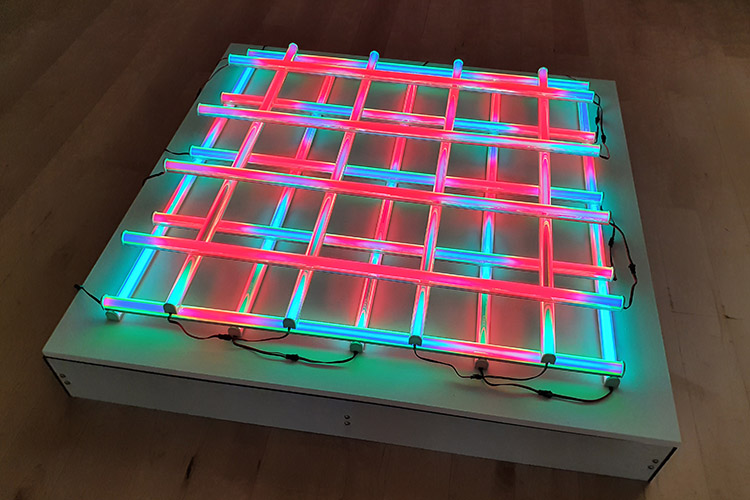
Matthew Biederman, Interference, 2018.
Interference is a lighting installation by Matthew Biederman conveying the wave-particle duality of light. He was inspired in particular by the “double-slit” experiment conducted in 1801 by Thomas Young, who demonstrated the wave nature of light by having two light beams interfere. Matthew Biederman is an artist who builds his path along his art residencies, between art and science. His sculpture displays a so-called ‘woodpile’ structure, particularly appreciated by researchers in nanotechnologies. Superimposed light patterns are animated according to rhythms that gradually harmonize and disharmonize while the dichroic filters which cover them offer the spectators as many light effects as there are viewpoints. Interference thus shows perfectly instability since it changes as much through time as according to one’s position in space. Watching it is an experience of contemplating an infinity of states without being able to predict any of them, just like scientists observe and learn from their successive experiences.
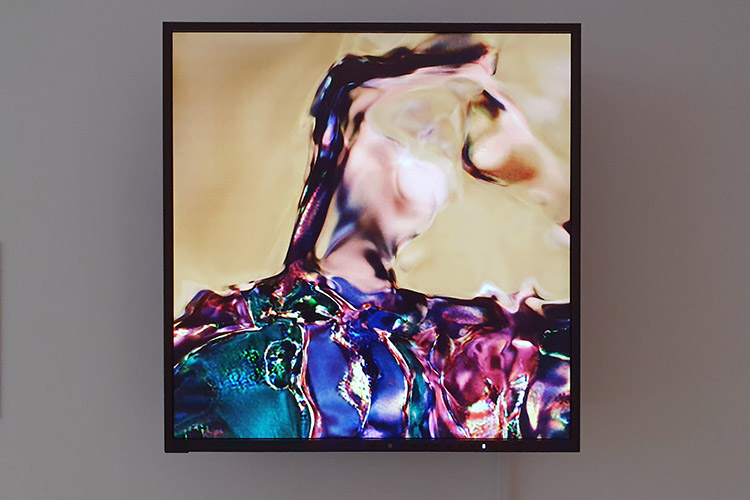
Xavier Snelgrove & Mattie Tesfaldet, Latent Space Interpolation, 2019.
If artworks habitually generate commentaries and analyses, others may come as conclusions to research papers, as is the case for Latent Space Interpolation by Xavier Snelgrove and Mattie Tesfaldet. These two artists-researchers, one based in Montreal and the other in Toronto, first wrote a scientific article entitled Fourier-CPPNs for Image Synthesis in collaboration with David Vazquez before putting their theory into practice and eventually an art piece. As a reminder, Joseph Fourier (1768-1830) is a French mathematician whose theories still have many applications in the world of image treatment. And it is precisely the crux of the matter: the machine – that is said to calculate in English (computer) and/or order in French (ordinateur) – recalculates while reordering them all the pictorial elements of the portraits of the two protagonists. A video loop ensues in which the faces of Xavier Snelgrove and Mattie Tesfadet literally liquefy into infinite transitions, featuring just as infinite possible representations of an in-between.
Intelligence et robots

Grégory Chatonsky, The Dreaming Machine, 2014-2019 (Audi Talents).
The Dreaming Machine installation by Grégory Chatonsky makes use of an artificial intelligence application known to experts as Recursive neural network. Continuously, it scans the 20,000 dreams of ordinary people previously collected by University of California researchers Adam Schneider and G. William Domhoff. Learning from those dreams, the machine then makes up new ones which a synthetic voice, in turn, shares with us. Meanwhile, another technology called Generative adversarial network creates the 'settings' of the spoken dreams by generating images through hybridization, mixing landscapes and architecture as well as nature and technologies. The machine’s dreams being generated through a sort of fusion of people’s obsessions, they appear all the more disorderly. Instead of being conducive to analysis, the fast-paced rhythm of the device erratically rambling through images, with its entrails of cables exposed, hypnotizes.
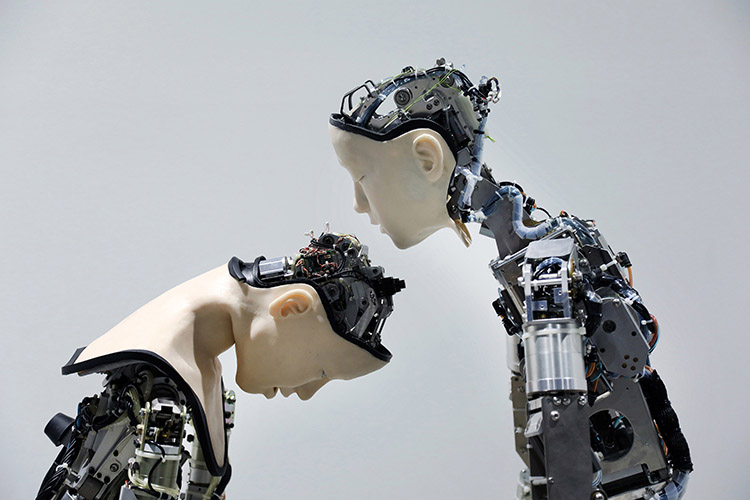
Justine Emard, Soul Shift, 2018 (Ishiguro lab & Ikegami Lab).
Alter is a humanoid robot that seems to wake up to the world when activated. Its singularity resides in its gestures that no human could really anticipate because they were created with great precision by an artificial intelligence. It is entirely autonomous thanks to the sensors that inform its neuronal network about its surroundings. It effectively invents its own motions according to the limits of its articulations, which are similar to ours. It – since the machine is genderless – seems to discover the inactive robot of which it is in fact the double or duplicate. The memory or 'mind' of Alter 1 has been transferred to Alter 2, and it makes us think of a kind of reincarnation, only without flesh. The film Soul Shift by Justine Emard is the promise of a possible encounter with a previous version of oneself. When faced with that other it was derived from, the active Alter seems intrigued by its inertia to the point of approaching it in a movement of mixed recognition and affection.
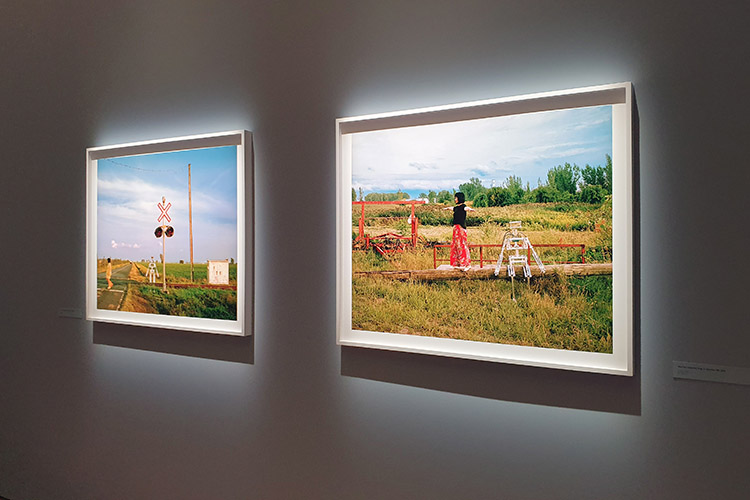
Chun Hua Catherine Dong, In Transition, 2018 (robot Bill Vorn).
In the photographs of her In transition series, Chun Hua Catherine Dong stages herself with an anthropomorphic robot in rather ordinary situations. With a little empathy, you’d easily forget the initial strangeness of this duo associating a female human to a metallic other. Along the images, the stage-by-stage narrative unfolds, and a rather peculiar road trip emerges: a story conveying similar situations that we may have experienced in reality or by proxy, about relationships that build up and unravel along journeys in literature as in film. The story happening here, though, is one that invites us to reconsider the mechanical other which has already started to people our environment under many forms. Indeed, by lending any form of intelligence to the technical objects that surround us, we also have to reassess their deep nature. And this is precisely where authors and artists can help us by propelling us into an imminent future.

Samuel St-Aubin, Prosperity, 2017.
Robot Prosperity reorganizes chaos while respecting diversity. It acts with utter transparency since none of its components is hidden by artist Samuel St-Aubin, who has conceived and built it. Prosperity picks up grains of rice and aligns them on a grid while preserving their respective original orientation. Symbolically, this robot thus teaches us how to handle a group without overlooking individualities. As the viewers are watching it at work, they can appreciate how right its motions are, like the seamless succession of gestures of skilled craftsmen. Along its repeated actions conducive to contemplation, Prosperity also teaches us patience a skill that successive industrial revolutions may well have replaced by immediate reactivity. If it weren’t for a few machines which, beyond the rhythms dictated by productivity, are made to slow down time where it is still allowed that is in the world of art.
Images and sounds
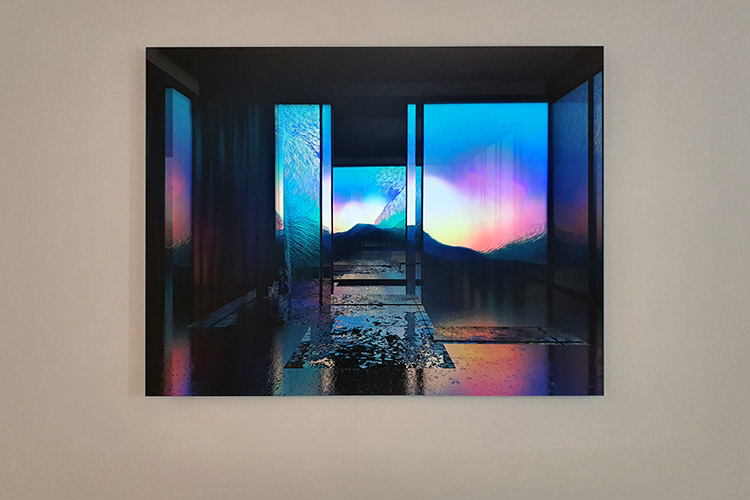
Sabrina Ratté, Alpenglow, 2018 (Ellephant & Charlot).
In architecture as in art, the history of shapes is interspersed with inventions and other innovations. They are for instance those same 3D applications that allow architects to anticipate their monuments and artists to conceive their spaces. Not to forget the use by artists such as Sabrina Ratté of video projectors with which they can augment city as well as imaginary constructions. With Alpenglow, you don’t really know anymore what you are watching. There is a disquieting strangeness in the image that both invites contemplation and deceives our perception. Because although the image of an interior space conducive to meditation seems stable, the light permeating its peculiar ambiance seems to change. Isn’t it the very purpose of technology in art and shows: to bring additional magic to the control of lighting? If only to deconstruct some of our assumptions.
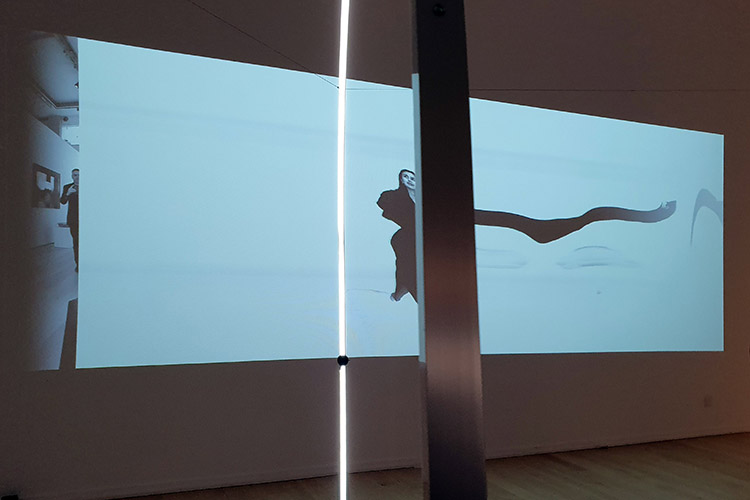
Louis-Philippe Rondeau, Liminal, 2018.
Liminal is an interactive device whose title, coming from the Latin liminalis, evokes the idea of threshold. It is a portal delineated by an arc of light that artist Louis-Philippe Rondeau invites us to cross. In doing so, the viewers enter into the video image which is projected according to a so-called 'slit-scan' photographic or cinematographic technique allowing to capture reality through slits. In the case of Liminal, these are bodies moving across the threshold of the arc into the image. The idea that you go in and out of the screen has always fascinated a number of filmmakers who keep pushing the boundaries of the industry. Upon passing the threshold, the sound is allegorically sculpted by the gestures of performers who improvise strange choreographies that light translate in real time into images, where their bodies appear transmogrified by singular ways of experiencing duration.

David Rokeby, Minimal Object (with time on your hands), 2012.
The minimal object which is presented to us is made of a frame covered by a canvas with no representation whatsoever. You would think it is abstract art at its most radical if the nature of the canvas, similar to that covering sound speakers, didn’t lead us to consider its ability to emit sounds. Hung to the wall, the square of Minimal Object marks the « playable » area of that instrument built by David Rokeby. Because the artist has placed sounds in the invisible space between us and the sound installation which is delivered without method or composition. Becoming instrumentalists as we come in contact with it, we have to learn to play the instrument as we are discovering it. Everything happens in that space which turns the viewers into players of a music thus pulled with bare hands out of the invisible. Such a practice of the immaterial perfectly symbolizes our repeated, daily manipulations of data which we couldn’t precisely locate either.
At the age of Internet
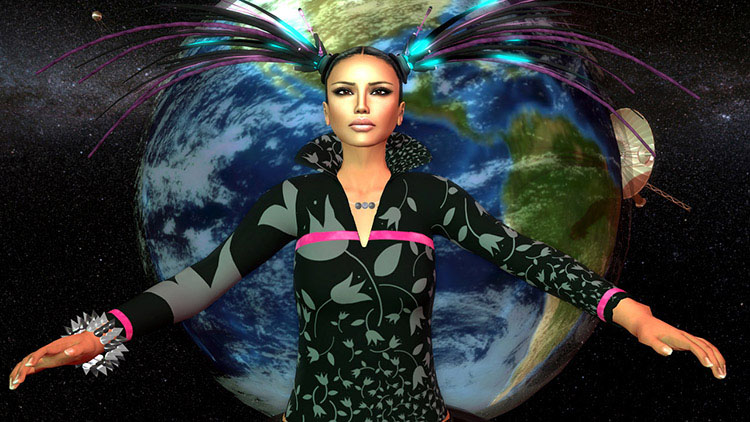
Skawennati, Satellite of Love, 2018 (Ellephant).
Skawennati is from Kahnawà:ke, in Mohawk territory, but you could fail to spot her in the old photographs of her people in traditional costumes that illustrate the North American native cultures in 20th century history books. Using the technology of her times, she prefers to project herself into futures where settings and actors or avatars come from the computation of networked servers. This is how she made several animation sequences within the virtual universes of Second Life. And from those, she lifted the still images that today she calls Machinigraphs. She is thus referring as much to the practice of photography as to the forms of writing that have emerged from the diverted uses of video games. By evoking the elements such as earth and water within settings made of polygons that only machines can display, she connects the concerns at the core of ancestral cultures which, in our hunger for innovation, we might have forgotten if it were not for the reminders of Mother Nature with the great challenges of the future.
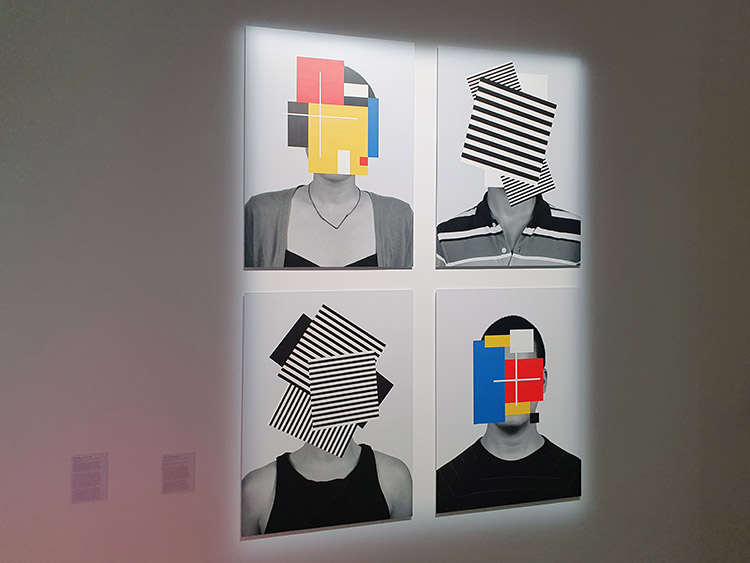
Douglas Coupland, Deep Face, 2015 (Daniel Faria).
Apply a few color blocks as a screen over the faces of people you know, and you may still be able to somehow recognize them. However, such graphical elements will unfailingly disable the best facial recognition software, including the Facebook technology which is supposed to be more powerful than its FBI counterpart. The fact that corporations should control AI technologies – and in particular deep learning technologies – which are more sophisticated than State-owned software is a challenging perspective regarding our democracies in the era of global surveillance. And although dreams of fame soared with the advent of television, it seems to us that the desire for anonymity might well win over in a near future. We would then opt for that 'facial dis-recognition' initiated by Douglas Coupland in his series of anti-portraits entitled Deep Face.

Émilie Brout & Maxime Marion, Lightning Ride, 2017.
In its participative mode, the Internet reveals strange communities or activities, in particular through platforms of video sharing that present a mix of amateur and artistic practices. This is where Émilie Brout & Maxime Marion searched for material in 2017 and collected certification sequences for permission to use a taser in the US, in which participants get tased by turns to experience the electric shock. The slow motion of Lightning Ride attenuates the violence originally visible in the scenes that repeat themselves while a similarly long-drawn score stresses its dramatic character. Image after image, the artists have also applied an 'oil painting' effect that refers both to the history of art and to the aesthetics of machines. Thus processed, the sufferings are reminiscent of ecstasy as represented in painting while the absolutely systematic treatment of the image suggest the relentlessness of algorithms and more largely of machines themselves.

Emilie Gervais, rapperBl0ckChain.gif, 2018.
This animation is normally only accessible on the Digital Objects platform where artists of the immaterial connect with art collectors. Its price has been symbolically set at its material equivalent: US $11.99. It is an eBay item called “Unisex 80’s Hip Hop Rapper Style 10 mm, 11 mm, 13 mm, 15 mm Cuban Chain Necklace RC1524”. The artwork’s title, RapperBl0ckChain.gif, also refers to the Blockchain, a data storing and transmission technology, transparent and secure, working without central control – allowing artists such as Emilie Gervais to follow the sales and acquisitions of their works. The chain, whose shining gold so fascinates hip-hop rappers, seems to have no effect on the waves frozen by time. They are only touched by its shadow which might suggest the unfurling of cryptocurrencies that servers are endlessly calculating – digital currencies that we will have to learn how to handle.
Articles
- Paris Photo
- Art, technology and AI
- Immersive Art
- Chroniques Biennial
- 7th Elektra Biennial
- 60th Venice Biennial
- Endless Variations
- Multitude & Singularity
- Another perspective
- The Fusion of Possibilities
- Persistence & Exploration
- Image 3.0
- BioMedia
- 59th Venice Biennale
- Decision Making
- Intelligence in art
- Ars Electronica 2021
- Art & NFT
- Metamorphosis
- An atypical year
- Real Feelings
- Signal - Espace(s) Réciproque(s)
- On Combinations at Work
- Human Learning
- Attitudes and forms by women
- Ars Electronica 2019
- 58th Venice Biennale
- Art, Technology and Trends
- Art in Brussels
- Plurality Of Digital Practices
- The Chroniques Biennial
- Ars Electronica 2018
- Montreal BIAN 2018
- Art In The Age Of The Internet
- Art Brussels 2018
- At ZKM in Karlsruhe
- Lyon Biennale 2017
- Ars Electronica 2017
- Digital Media at Fresnoy
- Art Basel 2017
- 57th Venice Biennial
- Art Brussels 2017
- Ars Electronica, bits and atoms
- The BIAN Montreal: Automata
- Japan, art and innovation
- Electronic Superhighway
- Lyon Biennale 2015
- Ars Electronica 2015
- Art Basel 2015
- The WRO Biennale
- The 56th Venice Biennale
- TodaysArt, The Hague, 2014
- Ars Electronica 2014
- Basel - Digital in Art
- The BIAN Montreal: Physical/ity
- Berlin, festivals and galleries
- Unpainted Munich
- Lyon biennial and then
- Ars Electronica, Total Recall
- The 55th Venice Biennale
- The Elektra Festival of Montreal
- Digital practices of contemporary art
- Berlin, arts technologies and events
- Sound Art @ ZKM, MAC & 104
- Ars Electronica 2012
- Panorama, the fourteenth
- International Digital Arts Biennial
- ZKM, Transmediale, Ikeda and Bartholl
- The Gaîté Lyrique - a year already
- TodaysArt, Almost Cinema and STRP
- The Ars Electronica Festival in Linz
- 54th Venice Biennial
- Elektra, Montreal, 2011
- Pixelache, Helsinki, 2011
- Transmediale, Berlin, 2011
- The STRP festival of Eindhoven
- Ars Electronica repairs the world
- Festivals in the Île-de-France
- Trends in Art Today
- Emerging artistic practices
- The Angel of History
- The Lyon Biennial
- Ars Electronica, Human Nature
- The Venice Biennial
- Nemo & Co
- From Karlsruhe to Berlin
- Media Art in London
- Youniverse, the Seville Biennial
- Ars Electronica, a new cultural economy
- Social Networks and Sonic Practices
- Skin, Media and Interfaces
- Sparks, Pixels and Festivals
- Digital Art in Belgium
- Image Territories, The Fresnoy
- Ars Electronica, goodbye privacy
- Digital Art in Montreal
- C3, ZKM & V2
- Les arts médiatiques en Allemagne
- Grégory Chatonsky
- Le festival Arborescence 2006
- Sept ans d'Art Outsiders
- Le festival Ars Electronica 2006
- Le festival Sonar 2006
- La performance audiovisuelle
- Le festival Transmediale 2006
- Antoine Schmitt
- Eduardo Kac
- Captations et traitements temps réel
- Maurice Benayoun
- Japon, au pays des médias émergents
- Stéphane Maguet
- Les arts numériques à New York